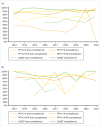Role of compliance in Helicobacter pylori eradication treatment: Results of the European Registry on H. pylori management
- PMID: 38685613
- PMCID: PMC11250393
- DOI: 10.1002/ueg2.12569
Role of compliance in Helicobacter pylori eradication treatment: Results of the European Registry on H. pylori management
Abstract
Background: Adherence to Helicobacter pylori (H. pylori) eradication treatment is a cornerstone for achieving adequate treatment efficacy.
Objective: To determine which factors influence compliance with treatment.
Methods: A systematic prospective non-interventional registry (Hp-EuReg) of the clinical practice of European gastroenterologists. Compliance was considered adequate if ≥90% drug intake. Data were collected until September 2021 using the AEG-REDCap e-CRF and were subjected to quality control. Modified intention-to-treat analyses were performed. Multivariate analysis carried out the factors associated with the effectiveness of treatment and compliance.
Results: Compliance was inadequate in 646 (1.7%) of 38,698 patients. The non-compliance rate was higher in patients prescribed longer regimens (10-, 14-days) and rescue treatments, patients with uninvestigated dyspepsia/functional dyspepsia, and patients reporting adverse effects. Prevalence of non-adherence was lower for first-line treatment than for rescue treatment (1.5% vs. 2.2%; p < 0.001). Differences in non-adherence in the three most frequent first-line treatments were shown: 1.1% with proton pump inhibitor + clarithromycin + amoxicillin; 2.3% with proton pump inhibitor clarithromycin amoxicillin metronidazole; and 1.8% with bismuth quadruple therapy. These treatments were significantly more effective in compliant than in non-compliant patients: 86% versus 44%, 90% versus 71%, and 93% versus 64%, respectively (p < 0.001). In the multivariate analysis, the variable most significantly associated with higher effectiveness was adequate compliance (odds ratio, 6.3 [95%CI, 5.2-7.7]; p < 0.001).
Conclusions: Compliance with Helicobacter pylori eradication treatment is very good. Factors associated with poor compliance include uninvestigated/functional dyspepsia, rescue-treatment, prolonged treatment regimens, the presence of adverse events, and the use of non-bismuth sequential and concomitant treatment. Adequate treatment compliance was the variable most closely associated with successful eradication.
Keywords: adherence; adverse effects; bismuth; dyspepsia; effectiveness; efficacy; first line; rate; regimens; rescue.
© 2024 The Authors. United European Gastroenterology Journal published by Wiley Periodicals LLC on behalf of United European Gastroenterology.
Conflict of interest statement
Specific Potential competing interests: Dr. Gisbert has served as a speaker, consultant, and advisory board member for or has received research funding from Mayoly, Allergan, Diasorin, Biocodex, Juvisé and Richen. Dr. Nyssen has received research funding from Mayoly, Allergan, Biocodex and Juvisé. The remaining authors declare that they have no conflicts of interest.
Figures



References
-
- Malfertheiner P, Megraud F, Rokkas T, Gisbert JP, Liou JM, Schulz C, et al. Management of Helicobacter pylori infection: the Maastricht VI/Florence consensus report. Gut. 2022;71(9):1724–1762. 10.1136/gutjnl-2022-327745 - DOI
-
- WHO . Adherence to long‐therm therapics. Evidence for action. Geneva: World Health Organization; 2004. http://apps.who.int/iris/bitstream/10665/42682/1/9241545992.pdf
Publication types
MeSH terms
Substances
Grants and funding
LinkOut - more resources
Full Text Sources
Medical
Research Materials
Miscellaneous

